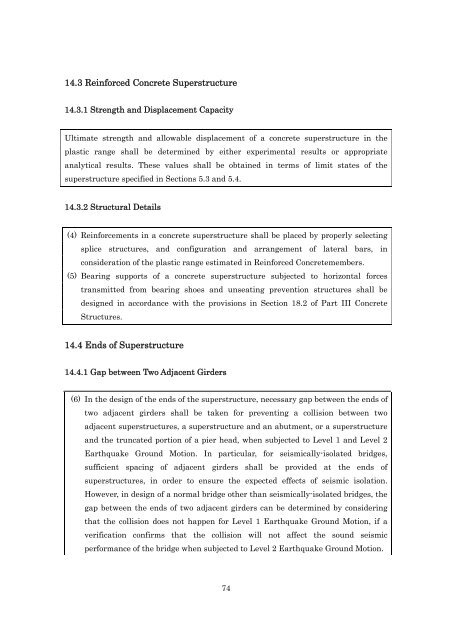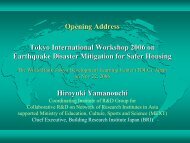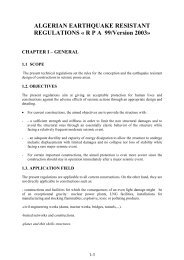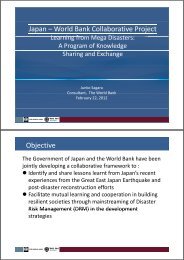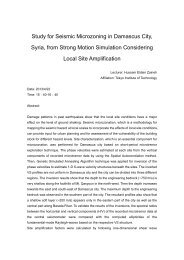DESIGN SPECIFICATIONS FOR HIGHWAY BRIDGES - IISEE
DESIGN SPECIFICATIONS FOR HIGHWAY BRIDGES - IISEE
DESIGN SPECIFICATIONS FOR HIGHWAY BRIDGES - IISEE
Create successful ePaper yourself
Turn your PDF publications into a flip-book with our unique Google optimized e-Paper software.
14.3 Reinforced Concrete Superstructure<br />
14.3.1 Strength and Displacement Capacity<br />
Ultimate strength and allowable displacement of a concrete superstructure in the<br />
plastic range shall be determined by either experimental results or appropriate<br />
analytical results. These values shall be obtained in terms of limit states of the<br />
superstructure specified in Sections 5.3 and 5.4.<br />
14.3.2 Structural Details<br />
(4) Reinforcements in a concrete superstructure shall be placed by properly selecting<br />
splice structures, and configuration and arrangement of lateral bars, in<br />
consideration of the plastic range estimated in Reinforced Concretemembers.<br />
(5) Bearing supports of a concrete superstructure subjected to horizontal forces<br />
transmitted from bearing shoes and unseating prevention structures shall be<br />
designed in accordance with the provisions in Section 18.2 of Part III Concrete<br />
Structures.<br />
14.4 Ends of Superstructure<br />
14.4.1 Gap between Two Adjacent Girders<br />
(6) In the design of the ends of the superstructure, necessary gap between the ends of<br />
two adjacent girders shall be taken for preventing a collision between two<br />
adjacent superstructures, a superstructure and an abutment, or a superstructure<br />
and the truncated portion of a pier head, when subjected to Level 1 and Level 2<br />
Earthquake Ground Motion. In particular, for seismically-isolated bridges,<br />
sufficient spacing of adjacent girders shall be provided at the ends of<br />
superstructures, in order to ensure the expected effects of seismic isolation.<br />
However, in design of a normal bridge other than seismically-isolated bridges, the<br />
gap between the ends of two adjacent girders can be determined by considering<br />
that the collision does not happen for Level 1 Earthquake Ground Motion, if a<br />
verification confirms that the collision will not affect the sound seismic<br />
performance of the bridge when subjected to Level 2 Earthquake Ground Motion.<br />
74


